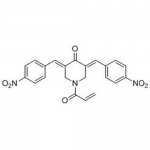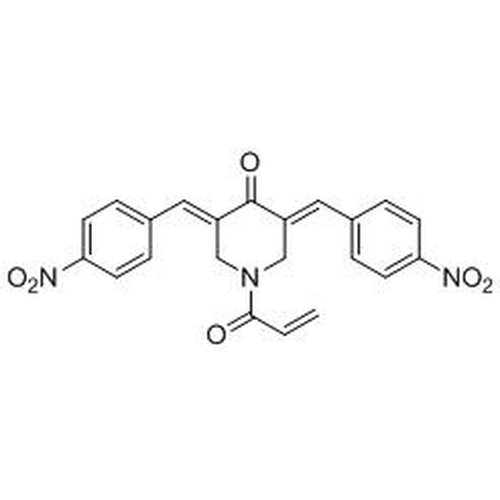| Product Name | b-AP15 |
| Description |
Deubiquitinase (DUB) Inhibitor (NSC-687852) |
| Purity | >98% |
| CAS No. | 1009817-63-3 |
| Molecular Formula | C22H17N3O6 |
| Molecular Weight | 419.4 |
| Field of Use | Not for use in humans. Not for use in diagnostics or therapeutics. For in vitro research use only. |
Properties
| Storage Temperature | -20ºC |
| Shipping Temperature | Shipped Ambient |
| Product Type | Inhibitor |
| Solubility | Soluble in 35 mg/ml DMSO |
| Source | Synthetic |
| Appearance | Pale Yellow Solid |
| SMILES | C=CC(=O)N1C/C(=CC2=CC=C(C=C2)[N+](=O)[O-])/C(=O)/C(=C/C3=CC=C(C=C3)[N+](=O)[O-])/C1 |
| InChI | InChI=1S/C22H17N3O6/c1-2-21(26)23-13-17(11-15-3-7-19(8-4-15)24(28)29)22(27)18(14-23)12-16-5-9-20(10-6-16)25(30)31/h2-12H,1,13-14H2/b17-11+,18-12+ |
| InChIKey | GFARQYQBWJLZMW-JYFOCSDGSA-N |
| Safety Phrases |
Classification: Caution – Substance not yet fully tested. Safety Phrases: S22 - Do not breathe dust S36/37/39 - Wear suitable protective clothing, gloves and eye/face protection S24/25- Avoid contact with skin and eyes |
| Cite This Product | b-AP15 (NSC-687852) (StressMarq Biosciences Inc., Victoria BC CANADA, Catalog # SIH-339) |
Biological Description
| Alternative Names | (3E,5E)-1-Acryloyl-3,5-bis(4-nitrobenzylidene)-4-piperidinone |
| Research Areas | Apoptosis, Cancer |
| PubChem ID | 5351435 |
| Scientific Background | b-AP15 is a selective inhibitor of the deubiquitinating enzymes UCHL5 and USP14, which are associated with the 19S regulatory particle of the proteasome. By blocking these enzymes, b-AP15 disrupts the removal of ubiquitin chains from proteasome substrates, leading to accumulation of polyubiquitinated proteins and induction of apoptosis. This mechanism has been explored in cancer models, but also holds relevance in neurodegenerative disease research, where impaired proteasomal degradation and protein aggregation are hallmark features. b-AP15 provides a valuable tool for studying the role of deubiquitination in neuronal proteostasis and may inform therapeutic strategies targeting the ubiquitin-proteasome system in disorders such as ALS and Huntington’s disease. |
| References | 1. D’Arcy P., et al. (2011) Nature Medicine 17: 1636. |



Reviews
There are no reviews yet.